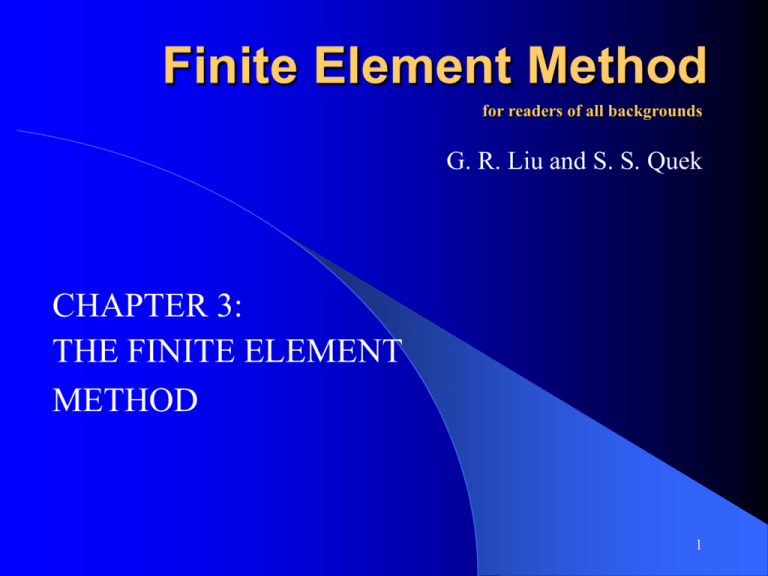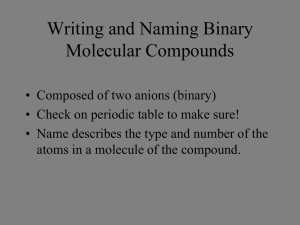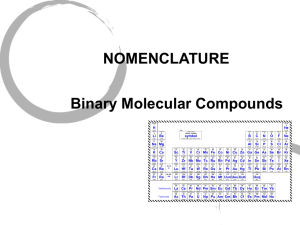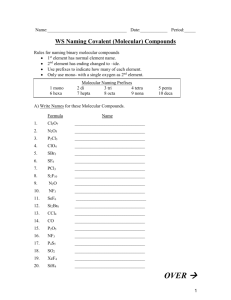Finite Element Method
advertisement

Finite Element Method
for readers of all backgrounds
G. R. Liu and S. S. Quek
CHAPTER 3:
THE FINITE ELEMENT
METHOD
1
CONTENTS
STRONG AND WEAK FORMS OF GOVERNING EQUATIONS
HAMILTON’S PRINCIPLE
FEM PROCEDURE
–
–
–
–
–
–
–
Domain discretization
Displacement interpolation
Formation of FE equation in local coordinate system
Coordinate transformation
Assembly of FE equations
Imposition of displacement constraints
Solving the FE equations
STATIC ANALYSIS
EIGENVALUE ANALYSIS
TRANSIENT ANALYSIS
REMARKS
Finite Element Method by G. R. Liu and S. S. Quek
2
STRONG AND WEAK
FORMS OF GOVERNING
EQUATIONS
System equations: strong form, difficult to solve.
Weak form: requires weaker continuity on the
dependent variables (u, v, w in this case).
Weak form is often preferred for obtaining an
approximated solution.
Formulation based on a weak form leads to a set
of algebraic system equations – FEM.
FEM can be applied for practical problems with
complex geometry and boundary conditions.
Finite Element Method by G. R. Liu and S. S. Quek
3
HAMILTON’S PRINCIPLE
“Of all the admissible time histories of
displacement the most accurate solution makes the
Lagrangian functional a minimum.”
An admissible displacement must satisfy:
– The compatibility equations
– The essential or the kinematic boundary conditions
– The conditions at initial (t1) and final time (t2)
Finite Element Method by G. R. Liu and S. S. Quek
4
HAMILTON’S PRINCIPLE
Mathematically
t Ldt 0 where L=T-P+Wf
t2
1
1
(Kinetic energy)
T U TUdV
2V
1
1
T
Π ε σ dV ε T cε dV (Potential energy)
2V
2V
W f U T f b dV
V
Sf
U T f s dS f
(Work done by
external forces)
Finite Element Method by G. R. Liu and S. S. Quek
5
FEM PROCEDURE
Step 1: Domain discretization
Step 2: Displacement interpolation
Step 3: Formation of FE equation in local coordinate
system
Step 4: Coordinate transformation
Step 5: Assembly of FE equations
Step 6: Imposition of displacement constraints
Step 7: Solving the FE equations
Finite Element Method by G. R. Liu and S. S. Quek
6
Step 1: Domain discretization
The solid body is divided into Ne elements with proper
connectivity – compatibility.
All the elements form the entire domain of the problem
without any overlapping – compatibility.
There can be different types of element with different
number of nodes.
The density of the mesh depends upon the accuracy
requirement of the analysis.
The mesh is usually not uniform, and a finer mesh is often
used in the area where the displacement gradient is larger.
Finite Element Method by G. R. Liu and S. S. Quek
7
Step 2: Displacement interpolation
Bases on local coordinate system, the displacement within
element is interpolated using nodal displacements.
nd
U( x, y, z ) N i ( x, y, z ) d i N( x, y, z )d e
i 1
d1
d
2
di
d n f
displacement compenent 1
displacement compenent 2
displacement compenent n f
d1 displacements at node 1
d
2 displacements at node 2
de
d nd displacements at node nd
Finite Element Method by G. R. Liu and S. S. Quek
8
Step 2: Displacement interpolation
N is a matrix of shape functions
N( x, y, z ) N1 ( x, y, z ) N 2 ( x, y, z )
for node 1
N i1
0
where N i
0
0
for node 2
0
Ni2
0
0
0
0
0
0
0 N in f
0
Finite Element Method by G. R. Liu and S. S. Quek
N nd ( x, y, z )
for node nd
Shape function
for each
displacement
component at a
node
9
Displacement interpolation
Constructing shape functions
– Consider constructing shape function for
a single displacement component
– Approximate in the form
u h ( x)
nd
i 1
pi (x)i pT (x)α
αT ={1 , 2 , 3 , ......, nd }
pT(x)={1, x, x2, x3, x4,..., xp}
(1D)
Finite Element Method by G. R. Liu and S. S. Quek
10
Pascal triangle of monomials: 2D
1 Constant terms: 1
3 terms
y
x
xy
x2
x
x
5
x 3y
4
x 4y
x 2y 2
x 3y 2
y2
xy2
x 2y
x3
Linear terms: 2
6 terms
10 terms
Quadratic terms: 3
y3 Cubic terms: 4
xy3
x 2y 3
y4
xy4
15 terms
21 terms
Quartic terms: 5
y5
Quintic terms: 6
pT (x) pT ( x, y ) 1, x, y, xy, x 2 , y 2 ,..., x p , y p
Finite Element Method by G. R. Liu and S. S. Quek
11
Pascal pyramid of monomials : 3D
1
Constant term: 1
4 terms
y
x
10 terms
Linear terms: 3
z
20 terms
y2
xy
x2
z2
2
xy2
xy
x3
xyz
xz2
x
x3y
x2yz
3
xz
2 2
xz
xz
3
y3
Cubic terms: 10
zy2
x2z
4
Quadratic terms: 6
yz
xz
35 terms
yz2
3
z
x2y2
xyz
xy3
xy2z
2
y4
zy3
Quartic terms: 15
2 2
zy
3
z4 z y
pT (x) pT ( x, y, z ) 1, x, y, z, xy, yz, zx, x 2 , y 2 , z 2 ,..., x p , y p , z p
Finite Element Method by G. R. Liu and S. S. Quek
12
Displacement interpolation
– Enforce approximation to be equal to the nodal
displacements at the nodes
di = pT(xi)
i = 1, 2, 3, …,nd
or
d1
p T (x1 )
de=P
d
T
p
(
x
)
2
2
where
de = ,
P
d nd
T
p (x nd )
Finite Element Method by G. R. Liu and S. S. Quek
13
Displacement interpolation
– The coefficients in can be found by
-1
α P de
– Therefore, uh(x) = N( x) de
N(x) pT (x)P -1 pT (x)P1-1 pT (x)P2-1
N2 ( x )
N1 ( x )
N1 (x) N 2 (x)
N n ( x)
Finite Element Method by G. R. Liu and S. S. Quek
pT (x)Pn-1
Nn ( x )
14
Displacement interpolation
Sufficient requirements for FEM shape
functions
1
1. Ni x j ij
0
n
2.
N ( x) 1
i 1
i
nd
3.
N ( x) x
i 1
i
i
x
i j,
j 1, 2,
i j, i, j 1, 2,
, nd
, nd
(Delta function
property)
(Partition of unity property –
rigid body movement)
(Linear field reproduction property)
Finite Element Method by G. R. Liu and S. S. Quek
15
Step 3: Formation of FE equations in local
coordinates
Strain matrix
Since U= Nde
Therefore, e = LU
Π
e = L N de= B de
1
1
1 T
T
T T
T
ε
c
ε
d
V
d
B
c
Bd
d
V
d
(
B
cBdV )d e
e
e
e
2 Ve
2 Ve
2
Ve
or
1 T
Π d e kde
2
where
T
k e B cBdV
Ve
(Stiffness matrix)
Finite Element Method by G. R. Liu and S. S. Quek
16
m e NT NdV
Ve
Step 3: Formation of FE equations in local
coordinates
Since U= Nde
T
or
U Nd e
1
1
1 T
T
T T
T
U
U
d
V
d
N
Nd
d
V
d
(
N
NdV )d e
e
e
e
2 Ve
2 Ve
2
Ve
1 T
T d e m ed e
2
where
m e NT NdV
Ve
(Mass matrix)
Finite Element Method by G. R. Liu and S. S. Quek
17
Step 3: Formation of FE equations in local
coordinates
W f dTe NT fb dV dTe NT f s dS dTe ( NT fb dV ) dTe ( NT f s dS )
Ve
Se
Ve
Se
W f d Fb d Fs d Fe
T
e
Fb
T
N f b dV
T
e
T
e
Fs
N T f s dS
Se
Ve
fe Fb Fs
(Force vector)
Finite Element Method by G. R. Liu and S. S. Quek
18
Step 3: Formation of FE equations in local
coordinates
t2
t1
t2
t1
1T 1 T
( d e m ed e - d e k ed e dTe Fe )dt 0
2
2
(Hamilton’s principle)
(d Te m ed e - dTe k ed e dTe Fe )dt 0
T
d
d
d
e
d (
) (dTe )
dt
dt
T
e
t2
t1
t2
t1
t2
t2
t2
T
T
T
dt
d e m ed e dt d e m e d e - d e m ed e dt - dTe m ed
e
t1
t1
- kd F )dt 0
dTe (-m ed
e
e
e
t1
f
k ed e m ed
e
e
FE Equation
Finite Element Method by G. R. Liu and S. S. Quek
19
Step 4: Coordinate transformation
f
kde m ed
e
e
(Local)
d e TD e
y'
F
K e De M e D
e
e
(Global)
Global
coordinate
systems
x'
Local coordinate
systems
y'
y
where
x'
x
K e T k e T , M e T m e T , Fe T f e
T
T
Finite Element Method by G. R. Liu and S. S. Quek
T
20
Step 5: Assembly of FE equations
Direct assembly method
– Adding up contributions made by elements
sharing the node
F
KD MD
KD F
(Static)
Finite Element Method by G. R. Liu and S. S. Quek
21
Step 6: Impose displacement constraints
No constraints rigid body movement
(meaningless for static analysis)
Remove rows and columns corresponding
to the degrees of freedom being constrained
K is semi-positive definite
Finite Element Method by G. R. Liu and S. S. Quek
22
Step 7: Solve the FE equations
Solve the FE equation,
F
KD MD
for the displacement at the nodes, D
The strain and stress can be retrieved by
using e = LU and s = c e with the
interpolation, U=Nd
Finite Element Method by G. R. Liu and S. S. Quek
23
STATIC ANALYSIS
Solve KD=F for D
– Gauss elmination
– LU decomposition
– Etc.
Finite Element Method by G. R. Liu and S. S. Quek
24
EIGENVALUE ANALYSIS
0
KD MD
Assume
(Homogeneous equation, F = 0)
D exp( it )
[K - 2M] 0
Let
2
[K - M] 0
det[K - M] K - M 0
[ K - i M ] i = 0
(Roots of equation are the
eigenvalues)
(Eigenvector)
Finite Element Method by G. R. Liu and S. S. Quek
25
EIGENVALUE ANALYSIS
Methods of solving eigenvalue equation
–
–
–
–
–
–
–
Jacobi’s method
Given’s method and Householder’s method
The bisection method (Sturm sequences)
Inverse iteration
QR method
Subspace iteration
Lanczos’ method
Finite Element Method by G. R. Liu and S. S. Quek
26
TRANSIENT ANALYSIS
Structure systems are very often subjected to
transient excitation.
A transient excitation is a highly dynamic time
dependent force exerted on the structure, such as
earthquake, impact, and shocks.
The discrete governing equation system usually
requires a different solver from that of eigenvalue
analysis.
The widely used method is the so-called direct
integration method.
Finite Element Method by G. R. Liu and S. S. Quek
27
TRANSIENT ANALYSIS
The direct integration method is basically using
the finite difference method for time stepping.
There are mainly two types of direct integration
method; one is implicit and the other is explicit.
Implicit method (e.g. Newmark’s method) is more
efficient for relatively slow phenomena
Explicit method (e.g. central differencing method)
is more efficient for very fast phenomena, such as
impact and explosion.
Finite Element Method by G. R. Liu and S. S. Quek
28
Newmark’s method (Implicit)
Assume that
2 1
Dt t Dt t Dt t - Dt Dt t
2
Dt t Dt t 1 - Dt Dt t
Substitute into KD CD MD F
2 1
K Dt t Dt t - Dt Dt t
2
C Dt t 1 - Dt Dt t MDt t Ft t
Finite Element Method by G. R. Liu and S. S. Quek
29
Newmark’s method (Implicit)
K cm Dt t Ftresidual
t
where
2
K cm K t Ct M
21
Ftresidual
F
K
D
t
D
t
t
t t
t
t
Dt - C Dt t 1 - Dt
2
-1 residual
Ft t
Therefore, Dt t K cm
Finite Element Method by G. R. Liu and S. S. Quek
30
Newmark’s method (Implicit)
Start with D0 and D0
Obtain D0 using KD CD MD F
-1 residual
cm t t
Obtain Dt using Dt t K F
March
forward
in time
Obtain Dt and Dt using
2 1
Dt t Dt t Dt t - Dt Dt t
2
Dt t Dt t 1 - Dt Dt t
Finite Element Method by G. R. Liu and S. S. Quek
31
Central difference method (explicit)
MD F - CD KD F - Fint F residual
D M -1F residual (Lumped mass – no need to solve matrix equation)
Dt t 2 t Dt Dt -t
Dt t 2 t Dt Dt -t
Dt
1
t
2
Dt -t Dt - t Dt
t
2
2
Dt
Dt t - 2Dt Dt -t
Finite Element Method by G. R. Liu and S. S. Quek
32
D0 and D0 are
prescribed and D0
can be obtained from
D,
D M -1F residual
x
x
x
Dt -t
x
x
Use Dt t / 2 t Dt Dt -t / 2 to
obtain Dt assuming Dt / 2 D0 .
Obtain Dt using D M -1F residual
Obtain D-t using
2
t
Dt - t Dt
Dt
2
Central
difference
method
(explicit)
t
-t -t/2 t0 t/2
t
Time marching in half the time step
Find average velocity D-t / 2 at time t =
-t/2 using D
t t / 2 t Dt Dt -t / 2
Find Dt / 2using the average acceleration at
time t = 0. D
t D D
t t / 2
t
t -t / 2
Find Dt using the average velocity at time t =t/2
Dt t / 2 t Dt Dt -t / 2
Finite Element Method by G. R. Liu and S. S. Quek
33
REMARKS
In FEM, the displacement field U is expressed by
displacements at nodes using shape functions N
defined over elements.
The strain matrix B is the key in developing the
stiffness matrix.
To develop FE equations for different types of
structure components, all that is needed to do is
define the shape function and then establish the
strain matrix B.
The rest of the procedure is very much the same
for all types of elements.
Finite Element Method by G. R. Liu and S. S. Quek
34




